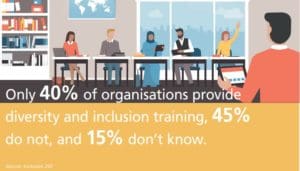In order to build a diverse and inclusive workforce, organisations need to carefully consider the language used in job descriptions.
By Simon Kent
Job descriptions often include qualities that organisations are seeking for particular roles: confidence, assertiveness, a born leader. But by using this type of language, companies may unknowingly limit themselves when attracting potential candidates.
“The language of any job advertisement can have a huge impact on the diversity hiring managers can expect to see from the responses,” says Kay Maddox-Daines, Head of School of People and Culture at Arden University. According to Kay, the use of jargon and abbreviations can directly appeal -or not appeal -to candidates with their subtle edge in the messaging.
“Certain types of more aggressive language, including terms such as born leader, demanding, or assertive are known to put off women when it comes to applying for a position,” says Maddox-Daines. “Instead, softer terms such as confident and diligent are likely to provoke a more balanced response and encourage a more diverse group of applicants.”
Marketing Manager for Monster Rod McMillan agrees. “Language has a big impact, especially on gender equality, diversity and Inclusion,” he says. “Careless use of language can bring unconscious bias into selection, and this can be harmful for companies.”
McMillan says Monster actively advises its users to mind their language, taking gender bias, racial bias, ageism, and disability into consideration. “Highlight your inclusive benefits, values, and diversity commitment,” he advises. “Don’t make people ask you about parental leave, flexible working practices, benefits like health insurance -some people won’t feel they can, for fear they’ll be judged. Placing these initiatives in plain sight shows you are an employer who takes diversity, flexible working, and inclusivity seriously -and will make you a much more attractive option for job seekers.”
There are technology platforms that can assess the language of a job description or advert and give a view on how well it might perform. But even without the help of AI, there are aspects of a job communication that will be off-putting regardless of how well it might be phrased. Statistics vary, but it is generally recognised that women will apply for a job if they feel they meet a reasonably high percentage of the criteria stated. Men, on the other hand, will apply even if they meet a lower percentage of criteria -open to taking the chance that they can convince their potential employer that they can do the job even if they don’t have the experience required.
At business software provider Advanced, this aspect of candidate attraction has taken centre stage. The company’s Director of Talent Transformation and Insight Nick Gallimore explains their industry not only features a mainly male workforce, but the majority of its talent pool is made up of males. As his company aspires to be diverse and inclusive, steps have been taken to address this issue at every stage of the talent funnel. The fact is simple: The business is not only looking for programmers and does not always need people with strong IT backgrounds. The solution is not to look for qualifications or similar experience, but to look for potential instead.
“We stopped saying, ‘you need five years of experience’ and started to describe the job we had instead,” says Gallimore. “We recruit on potential but rather than burying that message, we’ve tried to push it back to the top of the application funnel.”
Gallimore has considered their language choice, however, promoting and implementing this kind of awareness is difficult to scale for a growing company of 3,000-plus employees. At the same time, he believes there’s a danger of disappearing down a ‘rabbit hole’ as language is sifted for multiple biases. Assessing everything for gender, race, and other specifications is simply not practical.
“We’ve done some internal training with the HR team around these concepts but mainly we’ve focused on looking for potential and making the hiring decision in a different way,” he says.
“An organisation’s commitment to diversity, equity, inclusion, and belonging must be more than words on a page, it’s about the actions they take including the behaviours they demonstrate,” says Teresa Boughey CEO of Jungle HR and founder of consultancy Inclusion 247. “When it comes to job advertisements, not only will the role description and imagery either attract or repel candidates, but salary transparency enables prospective employees to not only benchmark, but can be a positive step towards closing gender, ethnicity and disability pay gaps.”
Inclusion 247’s recent Accelerating Inclusion report asked organisations about their provision of diversity and inclusion training to individuals involved in the recruitment and selection process. They found only two in five organisations (40%) provide this training, 45% did not, and 15% responded ‘didn’t know.’
“Such training should not only be offered to HR teams, but also the line managers or senior leaders who will be involved in all areas of recruitment, including role architecture, role specification, and candidate selection,” advises Boughey. “Increasing awareness will help to mitigate the impact of bias, however it needs to be supported by practical actions including reviewing each other’s language choices and working with external people when required to review communications.”
Language is ultimately another piece of the diversity agenda. But according to Simon Roderick, founder and MD of Fram Search, candidates are increasingly looking to see that organisations truly practice what they preach. “Five years ago no female candidate asked about board composition whereas now it’s rightly a very important question asked whenever they’re considering a role,” he says. “If you see a woman on the board, or if there’s someone like you on the board, you have a role model showing you that you can make it too. It’s about having that belief.”














